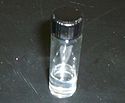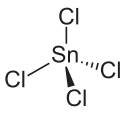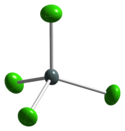- Tin(IV) chloride
-
Tin(IV) chloride 


 Tetrachlorostannane
Tetrachlorostannane
Tin tetrachloride
Tin(IV) chlorideOther namesStannic chlorideIdentifiers CAS number 7646-78-8 
ChemSpider 22707 
EC number 231-588-9 UN number 1827 RTECS number XP8750000 Jmol-3D images Image 1 - Cl[Sn](Cl)(Cl)Cl
Properties Molecular formula SnCl4 Molar mass 260.50 g/mol (anhydrous)
350.60 g/mol (pentahydrate)Appearance fuming liquid Density 2.226 g/ml (anhydrous)
2.04 g/cm3 (pentahydrate)Melting point -33 °C
Boiling point 114.15 °C
Solubility in water decomposes (anhydrous)
very soluble (pentahydrate)Solubility soluble in alcohol, benzene, toluene, chloroform, acetone, kerosene Hazards MSDS ICSC 0953 EU Index 050-001-00-5 EU classification Corrosive (C) R-phrases R34, R52/53 S-phrases (S1/2), S7/8, S26, S45, S61 NFPA 704 Related compounds Other anions Tin(IV) fluoride
Tin(IV) bromide
Tin(IV) iodideOther cations Carbon tetrachloride
Silicon tetrachloride
Germanium tetrachloride
Tin(II) chloride
Lead(IV) chloride chloride (verify) (what is:
chloride (verify) (what is:  /
/ ?)
?)
Except where noted otherwise, data are given for materials in their standard state (at 25 °C, 100 kPa)Infobox references Tin(IV) chloride, also known as tin tetrachloride or stannic chloride is a chemical compound with the formula SnCl4. At room temperature it is a colourless liquid, which fumes on contact with air, giving a stinging odor. It was first discovered by Andreas Libavius (1550–1616) and was known as "spiritus fumans libavii" .[1]
Contents
Preparation
It is prepared from reaction of chlorine gas with elemental tin.
- Sn + 2 Cl2 → SnCl4
Reactions
When mixed with a small amount of water a semi-solid crystalline mass of the pentahydrate, SnCl4.5H2O is formed.[1] This was formerly known as butter of tin[1]. This compound has been shown to be best described as [SnCl4(H2O)2].3H2O, consisting of cis-[SnCl4(H2O)2] units linked in chains with three hydrate water molecules.[2]
With hydrochloric acid the complex [SnCl6]2− is formed making the so-called hexachlorostannic acid.[1]
Anhydrous tin(IV) chloride is a strong Lewis acid and complexes with e.g. ammonia, phosphine and phosphorus pentachloride are known.[1] SnCl4 is used in Friedel-Crafts reactions as a catalyst for homogeneous alkylation and cyclisation.[1]
With Grignard reagents tetraalkyltin compounds can be prepared:[3]
- SnCl4 + RMgCl → SnR4
Uses
Stannic chloride was used as a chemical weapon in World War I, as it formed an irritating (but non-deadly) dense smoke on contact with air: it was substituted for by a mixture of silicon tetrachloride and titanium tetrachloride near the end of the War due to shortages of tin.[4] It is also used in the glass container industry for making an external coating containing tin(IV) oxide which toughens the glass. It is a starting material for organotin compounds.
Stannic chloride is used in chemical reactions with fuming (90%) nitric acid for the selective nitration of activated aromatic rings in the presence of unactivated ones.[5]
References
- ^ a b c d e f Egon Wiberg, Arnold Frederick Holleman (2001) Inorganic Chemistry, Elsevier ISBN 0-12-352651-5
- ^ Barnes, John C.; Sampson, Hazel A.; Weakley, Timothy J. R. (1980). "Structures of di-μ-hydroxobis[aquatrichlorotin(IV)]-1,4-dioxane(1/3), di-μ-hydroxobis[aquatrichlorotin(IV)]-1,8-epoxy-p-menthane(1/4), di-m-hydroxobis[aquatribromotin(IV)]-1,8-epoxy-p-menthane(1/4), di-μ-hydroxobis[aquatrichlorotin(IV)], and cis-diaquatetrachlorotin(IV)". J. Chem. Soc., Dalton Trans. (6): 949. doi:10.1039/DT9800000949.
- ^ Greenwood, Norman N.; Earnshaw, Alan (1997). Chemistry of the Elements (2nd ed.). Oxford: Butterworth-Heinemann. ISBN 0080379419.
- ^ Fries, Amos A. (2008). Chemical Warfare. Read. pp. 148–49, 407. ISBN 1443738409.
- ^ Thurston, David E.; Murty, Varanasi S.; Langley, David R.; Jones, Gary B. (1990). "O-Debenzylation of a Pyrrolo[2,1-c][1,4]benzodiazepine in the Presence of a Carbinolamine Functionality: Synthesis of DC-81". Synthesis 1990: 81–84. doi:10.1055/s-1990-26795.
External links
Tin compounds Categories:- Chlorides
- Tin compounds
- Metal halides
Wikimedia Foundation. 2010.

